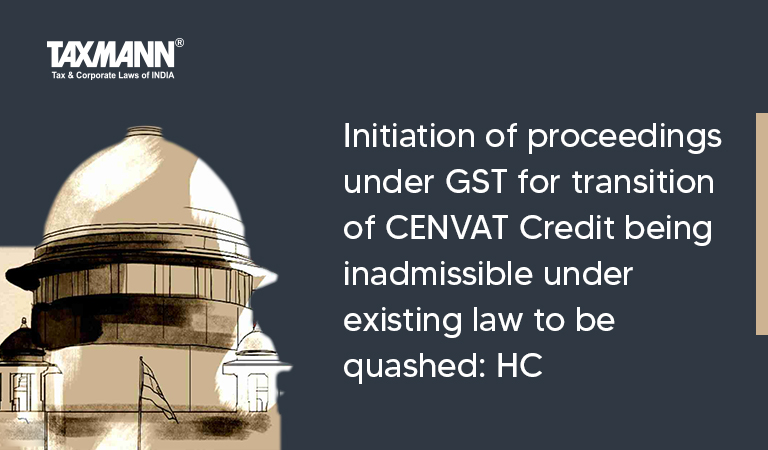Initiation of proceedings under GST for transition of CENVAT Credit being inadmissible under existing law to be quashed: HC
- Blog|News|GST & Customs|
- 2 Min Read
- By Taxmann
- |
- Last Updated on 3 December, 2022

Case Details: Usha Martin Ltd. v. Additional Commissioner, Central GST and Excise - [2022] 145 taxmann.com 224 (Jharkhand)
Judiciary and Counsel Details
-
- Aparesh Kumar Singh & Deepak Roshan, JJ.
- Ms Sujit Ghosh, Joybrata Misra, Ashray Behura & Shubham Gautam, Advocates for the Petitioner.
- Ms Amit Kumar, Ashish Kr. Shekhar, Advocates & Prabhat Kr. Sinha, CGC for the Respondent.
Facts of the Case
The proceedings were initiated against petitioner by issuance of show cause notice in Form GST-DRC-01 proposing recovery of transitioned CENVAT credit in terms of Section 73(1) of the CGST Act, 2017 along with interest and penalty. It filed writ petition and raised the question of lack of jurisdiction of the adjudicating authority to decide upon the availment of CENVAT credit by the petitioner.
It was contended that proceedings for wrongful availment of CENVAT Credit had been initiated by revenue under Section 73 (1) of CGST Act instead of relevant provisions of Finance Act read with Rule 14 of Cenvat Credit Rules 2004 and disallowed CENVAT credit carried forward by petitioner by filing TRAN-1.
High Court Held
The Honorable High Court noted that as per Section 73 of CGST Act, 2017, the proceeding can be initiated for non-payment of any tax or short payments or for erroneous refund or for wrongfully availing or utilizing input tax credit which are available under CGST Act. However, Section 73 does not speak of CENVAT Credit as CGST Act does not provide for CENVAT Credit rather term has been subsumed in expression input tax credit both relating to supply of good or services. The assumption of jurisdiction to determine whether CENVAT Credit was admissible under existing law by invoking provisions of Section 73 of CGST Act was not proper in the eyes of law.
Therefore, the Court held that the initiation of proceedings under Section 73 (1) of CGST Act, 2017 against petitioner for transition of CENVAT Credit as being inadmissible under existing law was beyond jurisdiction.
Disclaimer: The content/information published on the website is only for general information of the user and shall not be construed as legal advice. While the Taxmann has exercised reasonable efforts to ensure the veracity of information/content published, Taxmann shall be under no liability in any manner whatsoever for incorrect information, if any.

Taxmann Publications has a dedicated in-house Research & Editorial Team. This team consists of a team of Chartered Accountants, Company Secretaries, and Lawyers. This team works under the guidance and supervision of editor-in-chief Mr Rakesh Bhargava.
The Research and Editorial Team is responsible for developing reliable and accurate content for the readers. The team follows the six-sigma approach to achieve the benchmark of zero error in its publications and research platforms. The team ensures that the following publication guidelines are thoroughly followed while developing the content:
- The statutory material is obtained only from the authorized and reliable sources
- All the latest developments in the judicial and legislative fields are covered
- Prepare the analytical write-ups on current, controversial, and important issues to help the readers to understand the concept and its implications
- Every content published by Taxmann is complete, accurate and lucid
- All evidence-based statements are supported with proper reference to Section, Circular No., Notification No. or citations
- The golden rules of grammar, style and consistency are thoroughly followed
- Font and size that’s easy to read and remain consistent across all imprint and digital publications are applied



 CA | CS | CMA
CA | CS | CMA
